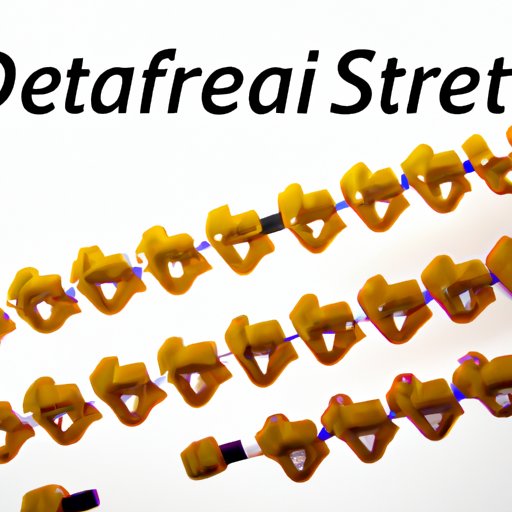Introduction
Attention Deficit Hyperactivity Disorder (ADHD) is a neurological disorder that causes inattentiveness, hyperactivity, and impulsivity. It affects both children and adults, and can interfere with daily functioning. One of the medications used to treat ADHD is Strattera, which is a type of selective norepinephrine reuptake inhibitor (SNRI). This article will explore how Strattera works to treat ADHD, looking at the science behind the medication, the results from clinical trials, and its side effects and risks.

Explaining the Science Behind How Strattera Works
Strattera is an SNRI, which means it works by affecting the levels of norepinephrine in the brain. Norepinephrine is a neurotransmitter that helps regulate attention, focus, and energy levels. By increasing the amount of norepinephrine available in the brain, Strattera helps to improve concentration, reduce hyperactivity, and manage impulsivity in people with ADHD.
The active ingredient in Strattera is atomoxetine hydrochloride, which is a chemical compound. When taken orally, atomoxetine is absorbed into the bloodstream and travels to the brain, where it binds to the norepinephrine transporter proteins. This prevents the transporters from taking up norepinephrine and thus increases the amount of the neurotransmitter available in the brain.

Examining the Clinical Trials of Strattera
Several clinical trials have been conducted to assess the safety and efficacy of Strattera for treating ADHD. The studies included a total of 4,008 patients aged 6-18 years old and assessed the effectiveness of Strattera compared to a placebo over a period of 8 weeks. The studies found that Strattera was significantly more effective than the placebo in improving symptoms of ADHD.
The studies also looked at the safety of Strattera compared to other medications. They found that the drug was generally well-tolerated and had a lower risk of side effects than other ADHD medications. Additionally, the studies found that Strattera was associated with fewer withdrawal symptoms than other medications.

Describing the Mechanism of Action of Strattera
Strattera works by increasing the availability of norepinephrine in the brain. This helps to improve focus, reduce impulsivity, and control hyperactivity in people with ADHD. Additionally, Strattera has been found to be less likely to cause side effects than other ADHD medications, such as stimulants.
In addition to its effects on norepinephrine, Strattera has also been found to affect dopamine and serotonin levels in the brain. This can help to improve mood and reduce anxiety in those with ADHD.
Comparing Strattera to Other ADHD Medications
Strattera is different from other medications used to treat ADHD, such as stimulants. Stimulants work by increasing the levels of dopamine and norepinephrine in the brain, while Strattera only increases the levels of norepinephrine. Additionally, Strattera is not a controlled substance, meaning it does not have the same potential for abuse as some other ADHD medications.
Strattera is also longer-acting than other ADHD medications. While stimulants typically last for several hours, Strattera can last for up to 24 hours. This means that it can provide relief from ADHD symptoms for a longer period of time.
Outlining the Side Effects of Strattera
Like any medication, Strattera can cause side effects. The most common side effects include nausea, constipation, dry mouth, insomnia, appetite loss, and fatigue. Less common but more serious side effects include liver damage, suicidal thoughts, and high blood pressure.
It is important to speak to a doctor before taking Strattera, as there are certain people who should not take the medication. Those with a history of mental health issues, liver or kidney problems, or heart conditions should not take Strattera.
Analyzing Studies on the Effectiveness of Strattera
Studies have found that Strattera is effective in improving symptoms of ADHD. In clinical trials, Strattera was found to be significantly more effective than a placebo in reducing inattentiveness, hyperactivity, and impulsivity. Additionally, the studies found that Strattera had a lower risk of side effects than other ADHD medications.
However, it is important to note that Strattera does not work for everyone. Some people may find that the medication does not provide enough relief from their symptoms. Additionally, Strattera can take several weeks to start working, so it may not provide immediate relief.
Conclusion
Strattera is a medication used to treat Attention Deficit Hyperactivity Disorder (ADHD). It works by increasing the levels of norepinephrine in the brain, which can help to improve focus, reduce impulsivity, and manage hyperactivity. Several clinical trials have been conducted to assess the safety and effectiveness of Strattera, and the studies found that it was more effective than a placebo in reducing ADHD symptoms. However, it is important to note that Strattera can cause side effects and may not work for everyone.
(Note: Is this article not meeting your expectations? Do you have knowledge or insights to share? Unlock new opportunities and expand your reach by joining our authors team. Click Registration to join us and share your expertise with our readers.)
